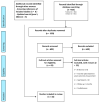A Systematic Review of the Efficacy of Microfocused Ultrasound for Facial Skin Tightening
- PMID: 36674277
- PMCID: PMC9861614
- DOI: 10.3390/ijerph20021522
A Systematic Review of the Efficacy of Microfocused Ultrasound for Facial Skin Tightening
Abstract
Objective: to systematically review the efficacy of microfocused ultrasound (MFU) for facial skin tightening. Methods: A systematic search was performed (Pubmed, Embase) to assess the efficacy of single MFU treatments for facial skin tightening. Eligible studies included randomised controlled trials, controlled trials, cohort studies and case series (n ≥ 10). Objective and subjective outcomes were assessed. Results: A total of 693 studies were identified of which 16 studies were eligible. All the studies involved female patients. MFU is capable of tightening the skin, as observed in studies measuring the results of brow lifts (0.47−1.7 mm) and submental lifts (measured as a 26−45 mm2 reduction in the submental area on lateral photographs). Data from the Global Aesthetic Improvement Scale (GAIS) were pooled, and the day 90 pooled subjective investigator reported scores (IGAIS) (n = 337) showed that 92% of the patients demonstrated an improvement in skin tightening and/or in wrinkle reduction which continued up to one year. Longer-term follow-up data are not available. The patient-reported pooled scores (SGAIS) (n = 81) showed that the skin improvements were mild and continued to increase from 42% (90 days) to 53% (360 days) post-treatment. The MFU treatment was moderately painful and caused transient erythema with or without oedema. Other adverse effects were rare (2%), including dysesthesia (numbness or hypersensitivity), bruising and stinging, mandibular burns, striations and contact dermatitis. Various device settings, treatment protocols and energies were applied. Excessive skin laxity and a BMI > 30 were posed as relative contraindications for MFU treatment because positive results declined with an increase in laxity and BMI. Conclusions: MFU treatment is effective in tightening female patients’ mildly to moderately lax facial skin. Future studies should focus on objective treatment outcomes, optimising treatment regimens and male patients.
Keywords: HIFU; cosmetic; laxity; microfocused ultrasound; rejuvenation; skin; wrinkle.
Conflict of interest statement
The authors declare no conflict of interest.
References
-
- White W.M., Maskin I.R., Barthe P.G., Slayton Gliklich R.E. Selective creation of thermal injury zones in the superficial musculoaponeurotic system using intense ultrasound therapy: A new target for noninvasive facial rejuvenation. Arch. Facial Plast. Surg. 2007;9:22–29. doi: 10.1001/archfaci.9.1.22. - DOI - PubMed
Publication types
MeSH terms
LinkOut - more resources
Full Text Sources
Medical
Miscellaneous


